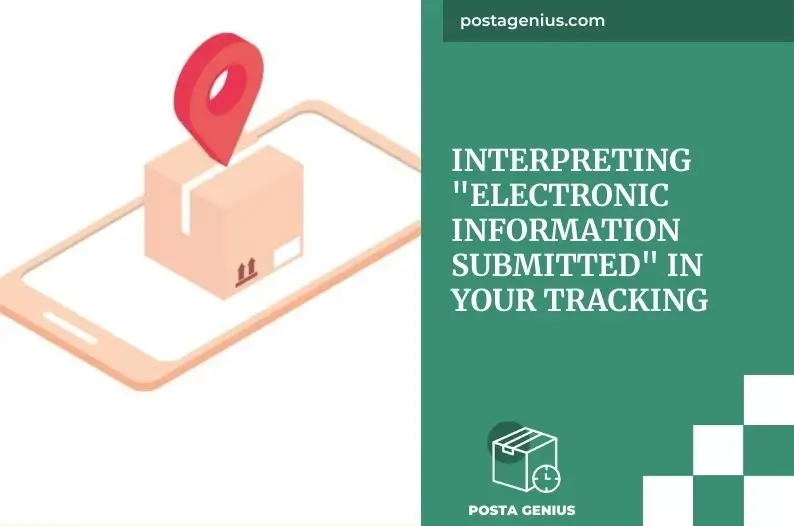Electronic Information Submitted by Shipper: What to Know

When shipping a package, understanding what “electronic information submitted by shipper” means can clarify the status of your shipment with Canada Post.
This term signifies that the shipper has provided necessary shipment details to Canada Post, initiating the delivery process.
Contents
- 1 Understanding the Meaning Behind Electronic Information Submitted by Shipper
- 1.1 How to Measure and Weigh Your Parcel for Submission
- 1.2 Essential Canada Post Resources for Shipping and Mailing
- 1.3 Understanding the “Electronic Information Submitted by Shipper” Alert
- 1.4 Interpreting “Electronic Information Submitted” in Your Tracking
- 1.5 Understanding the Timing After “Electronic Information Submitted”
- 1.6 Factors Influencing Delivery Timelines
- 2 Conclusion
- 3 FAQs
- 3.0.1 1. What does “electronic information submitted by shipper” mean on Canada Post tracking?
- 3.0.2 2. Why does my package show “electronic information submitted” for several days?
- 3.0.3 3. How accurate are the weight measurements at the post office compared to home scales?
- 3.0.4 4. What tools does Canada Post offer for calculating shipping costs?
- 3.0.5 5. How do I measure and weigh a parcel correctly for Canada Post?
Understanding the Meaning Behind Electronic Information Submitted by Shipper

When you receive a Canada Post tracking update indicating “electronic information submitted by shipper,” it means the shipper has provided key shipment details like the destination address, package weight, and service type.
This initial step integrates the parcel into the postal system, setting the stage for the delivery process.
As someone who regularly ships packages, understanding this term ensures all necessary information is relayed accurately for timely delivery.
How to Measure and Weigh Your Parcel for Submission
Accurate measurements and weights are crucial to comply with Canada Post guidelines and avoid delivery delays or incorrect shipping charges.
Taking Measurements Accurately
- Use a measuring tape or ruler to determine the parcel’s length, width, and height.
- For irregularly shaped parcels, measure the longest and widest points for overall dimensions.
Weighing Your Parcel

- Use a reliable, calibrated scale to weigh your parcel.
- Record the weight in pounds or kilograms accurately to avoid discrepancies.
Ensuring Accuracy
- Round up measurements to the nearest whole number.
- Include additional packaging in the overall dimensions.
- When in doubt, err on the side of caution and round up to prevent issues.
Taking time to verify measurements and weights ensures a smooth submission process and efficient handling.
Also Read : fedex stuck on label created
Comparing Parcel Weights
Ensuring your home scale is properly calibrated can reduce discrepancies at the post office.
For example, a parcel weighing 3.1 pounds at home might show 3.4 pounds at the post office, potentially increasing costs and delaying delivery.
Double-checking weights at the post office ensures accuracy.
Essential Canada Post Resources for Shipping and Mailing
Canada Post offers a range of resources to aid in the shipping and mailing process, from customer guides on packaging and customs regulations to tools that simplify the process.
Customer Guides and Pricing Information
Customer guides provide step-by-step instructions on postal services, ensuring compliance with packaging and customs requirements.
Detailed pricing information helps you plan and budget effectively.
Tools for Accurate Shipping
The “Find a Postal Code” tool ensures accurate addressing. Utilizing these resources helps avoid delays and ensures efficiency, making managing shipments seamless and reliable.
Understanding the “Electronic Information Submitted by Shipper” Alert
Early Submission of Shipping Details
When you see a Canada Post tracking update stating “electronic information submitted by shipper,” it doesn’t always mean your package is already on the move.
Often, this status appears because the sender has preemptively generated a tracking number and input the shipment details without having actually handed over the parcel to Canada Post or their designated pickup service.
This proactive step is crucial in streamlining the shipping process, yet it can create a sense of anticipation for the sender and receiver alike.
Delays Between Electronic and Physical Handling
The gap between this electronic notification and the physical scan at a Canada Post facility can vary.
Sometimes, this is due to the package still being in transit from the shipper to the postal facility.
Other times, discrepancies in the data syncs between the shipper’s systems and Canada Post’s tracking system can extend this waiting period. A
dditionally, technical issues might occasionally disrupt the expected flow of updates, preventing an error or tech issue from updating the scan status properly.
As a frequent online shopper and sender, recognizing these nuances helps manage expectations regarding delivery timelines.
Explore This Information : In Transit to Next Facility
Interpreting “Electronic Information Submitted” in Your Tracking

When the tracking update for your package shows “electronic information submitted,” it doesn’t necessarily signal a delay or problem with your delivery.
This status typically indicates that the shipper has registered the shipment details with Canada Post, but the actual package might not yet be in the postal system.
It’s a standard early phase where the package remains labeled online but hasn’t moved physically.
As someone who frequently sends and receives packages, I’ve noticed this status can linger before the package undergoes further scans.
Actions to Take if the Status Persists
However, if this status persists for more than a few days without additional tracking updates, it could suggest several issues.
It might mean the package was never actually tendered to Canada Post by the shipper, or there could be a technical issue or error preventing the scans from being updated.
If your tracking shows no change after 2-3 days, it’s advisable to contact the shipper to confirm that the item has indeed been handed off and to inquire about any potential delays.
My own experiences remind me to always check in if there’s an unusual pause in tracking updates, as this can preempt potential complications.
Understanding the Timing After “Electronic Information Submitted”
After receiving the “electronic information submitted” notice from Canada Post, it’s typical to expect the next scan and tracking update within 2-4 business days.
This timeline indicates that Canada Post has officially received the item from the shipper and it has begun its journey through their extensive network.
However, as someone who regularly tracks shipments, it’s important to note that these timeframes can vary.
Factors influencing the timing include the type of shipping service used—whether ground, air, priority, or express—with express services generally moving quicker through the system than standard options.
Factors Influencing Delivery Timelines
Several other variables play a role in determining when your package might progress. If the package originated from an international location, customs procedures can introduce additional delays.
Similarly, current volumes and weather conditions are known to affect the delivery network, potentially slowing down transit.
The distance to the destination and the number of facilities the package must route through can also extend the time until the next update.
Keeping these aspects in mind helps set realistic expectations for when tracking scans might show that your package has entered the Canada Post network and provide a clearer picture of the estimated delivery date.
Stay Informed : Processed Through ISC Los Angeles
Conclusion
Understanding shipping terms and processes is essential for smooth deliveries.
Accurate measurements and weights, combined with Canada Post’s resources like the Online Shipping Calculator and customer guides, help prevent delays and extra charges.
These tools ensure all shipment details are accurate, making the submission process seamless and reliable.
By being precise and using available resources, shippers can achieve a more efficient and trustworthy shipping experience.
FAQs
1. What does “electronic information submitted by shipper” mean on Canada Post tracking?
“Electronic information submitted by shipper” means that the shipper has provided Canada Post with the shipment details such as destination address, package weight, and service type.
This indicates that the package information is in the system, but the physical parcel may not yet be in transit.
2. Why does my package show “electronic information submitted” for several days?
This status may persist due to delays between the shipper submitting the information and the actual handover of the package to Canada Post.
It could also be due to data sync issues between the shipper’s system and Canada Post or the package still being in transit to a postal facility.
3. How accurate are the weight measurements at the post office compared to home scales?
Post office scales are typically more accurate because they are regularly calibrated and maintained. Home scales can vary in accuracy, leading to discrepancies.
It’s recommended to double-check weights at the post office to ensure precise shipping charges and avoid delays.
4. What tools does Canada Post offer for calculating shipping costs?
Canada Post offers an Online Shipping Calculator, which helps estimate shipping costs based on package size, weight, and destination.
This tool provides accurate cost estimates, allowing shippers to plan and budget effectively.
5. How do I measure and weigh a parcel correctly for Canada Post?
Use a measuring tape to determine the length, width, and height of the parcel. For irregularly shaped parcels, measure the longest and widest points.
Weigh the parcel using a reliable, calibrated scale and record the weight in pounds or kilograms.
Round up measurements to the nearest whole number and include additional packaging dimensions.






